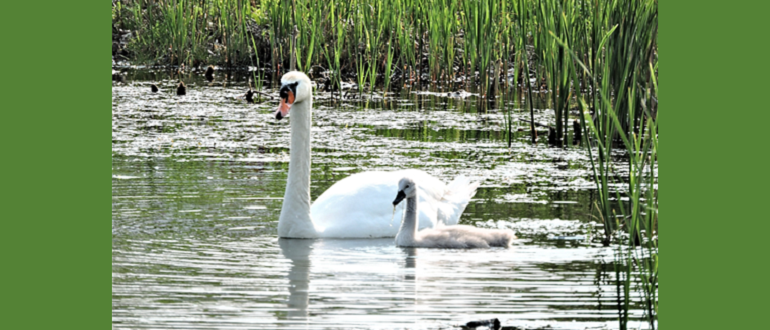GET TO KNOW: Mute Swans
Swans are majestic creatures. They grace our local waterways with such beauty that passersby often pause in admiration. Regrettably though, most swans sighted around Michigan are mute swans and thus a source of significant controversy. Mute swans, while beautiful, are a non-native species that is well-adapted to life in the suburbs. Since the
species is non-migratory, they were once considered the ideal, living lawn ornament for East Coast estate homes. Of course, as so often happens, some of those early “pet” swans took to the wild. Over time, the wild populations flourished and spread. Unfortunately, now – some hundred years later – mute swans have gained the undesirable status of being labeled as a “nuisance invasive species” in many US states.
FUN FACT
Mute swans are not really mute. They do have a vocal call though it is somewhat quieter than the call of trumpeter swans. In addition, swans make very loud noises with their wings. During their long take-off maneuvers, swans loudly
slap the water with their beating wings, and once airborne, their loud, rhythmic wing movements resonate through the air like a
form of music.
Because they are non-migratory, mute swans reside in Michigan year-
round. Even on snowy winter days, these graceful birds may be seen
gliding across the water. (Photo taken at Wilcox Lake in Plymouth.)
Well able to withstand cold temperatures, they survive winter months
by moving between unfrozen waterways and nearby fields where they
forage for leftover crops Territorial and rather aggressive by nature, mute swans are known to
dominate wetland breeding grounds where they often chase away
smaller waterfowl and curious humans. Additionally, these very large
birds have equally large appetites. When gathered as a flock, they can
do significant damage to the vegetation in wetland areas. Consequently, many state level DNR agencies, including the Michigan DNR, have policies to monitor, manage and control mute swan populations.
In addition to mute swans, two species of native swans are sometimes found in Michigan. All three species look
similar and are best distinguished by bill color. The invasive mute swans have bright orange bills while the two
native species – trumpeter and tundra swans – have black bills.
Both trumpeter and tundra swans are migratory and only visit Michigan part of the year. Some trumpeter swan populations spend summer breeding seasons in the Great Lakes region where they nest in remote areas atop beaver dams and muskrat lodges. However, tundra swans generally only stop in Michigan for brief rests along a long migration path that stretches from the artic tundra to the warmer skies of southern areas.
The Conundrum
In some ways, one must wonder how the presence of three beautiful, swan species could be considered a
problem. Afterall, what’s not to love about swans?
The problem, as is so often the case, is that people interfered with the natural balance of wetland ecosystems. It
is a sad irony that – at the same time mute swans were imported to grace the lawns of the wealthy – trumpeter
swans were hunted for hat feathers. Excessive hunting, combined with the ongoing destruction of wetland
habitats, once placed trumpeter swans in danger of extinction.
Recently, diligent conservation efforts have helped improve the status of our beautiful trumpeters. So, after two centuries of meddling with nature, we have managed to create a double conundrum. Our beautiful, native swan fights for a place in the modern world; and the beautiful, exotic swan is labeled a nuisance to be managed and controlled. When will we ever learn?
Categories
-
News & EventsLearn more about upcoming FOTR events and projects

